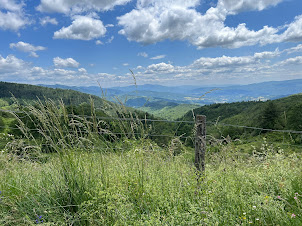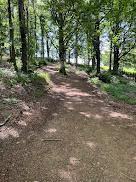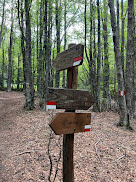

Left: A view over the Casentino Hills in Tuscany Italy. Right: Beech trees near the source of the Arno River on Monte Falterona.
Length: 13.2 km
Duration: 5.33 hours, includes stop for lunch and looking at plants
Elevation: 600 m gain
Location: Italy, Tuscany, Arezzo, Casentino Hills
The Casentino is one of the four valleys in the Province of Arezzo, Italy. The Casentino valley runs approximately northwest from Arezzo. This hike is on the southern slope of Monte Falterona at the northern end of the valley, on the edge of the Parco Nazionale delle Foreste Casentinesi, Monte Falterona, Campigna, a national park in Italy.
There are many possible paths to reach the source of the Arno and the nearby Lago degli Idoli, or the peak of Monte Falterona. Here are two:
The year prior, we hiked around the Monastero di Camaldoli and Hermitage di Camaldoli, which had a similar feel to this hike. On that trip, we stayed at Borgo Romena.
The Arno is the 8th largest river in Italy – by length. (The Po River is the longest.) The Arno is 241 km (about 150 mi) long and originates west of Florence in the Casentino area of the Apennines, where this hike is. After passing through Florence and under the famous Ponte Vecchio, the Arno River continues westward toward Pisa and eventually empties into the Tyrrhenian Sea.
We spent 9 months living in Florence in 2007-2008 (blog posts). We crossed the Arno many times during our 9 month stay. We lived on the shady side (southern) of the Arno, called the Oltrarno and we typically crossed the Ponte Vecchio and especially the Ponte Alle Grazie a few times a day. One thing we remember are the many signs pointing out the high-water mark of the disastrous 1966 flood of the Arno. The flood had a lasting impact on the city of Florence, killing over 100 people and destroying masterpieces of art and rare books.
The Capo d’Arno means the “head of the Arno” or sorgente (“source”) and is located at 1,358 m on the southern slope of Monte Falterona, which rises to 1,654 m. Dante – born in and most famously associated with Florence – visited the Capo d'Arno and there is a commemorative plaque with words lifted from Dante’s Purgatorio, Canto XIV
"…. quel fiumicel che nasce in Falterona e cento miglia di corso nol sazia”
Dante’s Purgatory is the second part of Dante’s Divine Comedy, following the Inferno and preceding the Paradiso. Dante’s purgatory is an island-mountain divided into three sections: Antepurgatory, Purgatory, and Earthly Paradise. In Canto XIV, we are in the second terrace of Purgatory, where the envious are punished. It’s in this context that the Arno River is mentioned and that it flows in lands (Casentino) where people are not virtuous. (So judgmental to their neighbors up river those people from Florence!)
The area around the headwaters of the Arno and the Lago degli Idoli is beech forest (Fagus sylvatica). In fact, this hike and the forest we were walking in are just outside the zone of the UNESCO designation: “Ancient and Primeval Beech Forests of the Carpathians and Other Regions of Europe”, a transnational serial property comprising 94 component parts across 18 countries. Nearby Sasso Fratino is the heart of the UNESCO designation in the Casentino forest.
The beech trees create a complete canopy so that you are mostly walking in shade. This is in contrast to the start of hike – at Madonna di Montalto – where it it's pine and oak trees and sunny openings.
It’s been a while since we’ve been out to identify plants, but here we go:
[Family] Genus species - Common name
[Boraginaceae] Echium vulgare – Viper's bugloss
![[Boraginaceae] Echium vulgare – Viper's bugloss [Boraginaceae] Echium vulgare – Viper's bugloss](https://blogger.googleusercontent.com/img/b/R29vZ2xl/AVvXsEg6M8-BA3MqHZrBXBq9ZSKyJy7AKXMkwHSCuTAiaNLRrXZFjCZVReSnpLfeNhhlGZ_Mgf62z3WbHJu3-Hjt0jbZvvpBcW0DROyoVw5HqIyUZFjzgzrjP_lI3kGsyImZjwcHjIEF20W50gfzvvVA0WlyDyNylGFcnS5DzVNGViHN21jJbApWNWelhQ3YhQ/w240-h320/%5BBoraginaceae%5D%20Echium%20vulgare.JPG)
![[Caryophyllaceae] Silene flos-cuculi – Ragged-robin [Caryophyllaceae] Silene flos-cuculi – Ragged-robin](https://blogger.googleusercontent.com/img/b/R29vZ2xl/AVvXsEg32lLpJXvPwlSQIcFUZlWSWR774uHyrulm1kv460_SmMdhT_Zn_ZNQ7chPnAArobI-AwXG70gGLwY6h-XL21z9Z6RMktoD2bERMCTEFkDzDmQrhtnNFkbMc6JDfRKTaYKBMP4Y9BIaqN9UfD1ZbtcA4_FFICG2Ecvxx5Zgbb0wy2p-KJQI_DSPzCsU8g/w240-h320/%5BCaryophyllaceae%5D%20Silene%20flos-cuculi.JPG)
Left: [Boraginaceae] Echium vulgare – Viper's bugloss
Length: 13.2 km
Duration: 5.33 hours, includes stop for lunch and looking at plants
Elevation: 600 m gain
Location: Italy, Tuscany, Arezzo, Casentino Hills
Overview
There are many possible paths to reach the source of the Arno and the nearby Lago degli Idoli, or the peak of Monte Falterona. Here are two:
- Papiano - Bocca pecorina - Vitareta - Lago degli Idoli - Andata / Ritorno
- Chiesa Madonna di Montalto - Lago degli idoli - Capo d'Arno
The year prior, we hiked around the Monastero di Camaldoli and Hermitage di Camaldoli, which had a similar feel to this hike. On that trip, we stayed at Borgo Romena.
Lago degli Idoli (or Lake of the Idols) is interesting because the Etruscans threw a lot of stuff into this lake like money, little statuettes, ex-voto with anatomical shapes, and weapons. Most of the booty disappeared over the years as the site was unprotected from looters from its discovery in 1838 onwards.
Left: Start of the trail near Madonna di Montalto. Center left: Lago degli Idoli, where Etruscans threw in little bronze statues. Center right and right: The source of the Arno River with plaque commemorating Dante's visit to the spot.
The Arno
We spent 9 months living in Florence in 2007-2008 (blog posts). We crossed the Arno many times during our 9 month stay. We lived on the shady side (southern) of the Arno, called the Oltrarno and we typically crossed the Ponte Vecchio and especially the Ponte Alle Grazie a few times a day. One thing we remember are the many signs pointing out the high-water mark of the disastrous 1966 flood of the Arno. The flood had a lasting impact on the city of Florence, killing over 100 people and destroying masterpieces of art and rare books.
The Capo d’Arno means the “head of the Arno” or sorgente (“source”) and is located at 1,358 m on the southern slope of Monte Falterona, which rises to 1,654 m. Dante – born in and most famously associated with Florence – visited the Capo d'Arno and there is a commemorative plaque with words lifted from Dante’s Purgatorio, Canto XIV
"…. quel fiumicel che nasce in Falterona e cento miglia di corso nol sazia”
Dante’s Purgatory is the second part of Dante’s Divine Comedy, following the Inferno and preceding the Paradiso. Dante’s purgatory is an island-mountain divided into three sections: Antepurgatory, Purgatory, and Earthly Paradise. In Canto XIV, we are in the second terrace of Purgatory, where the envious are punished. It’s in this context that the Arno River is mentioned and that it flows in lands (Casentino) where people are not virtuous. (So judgmental to their neighbors up river those people from Florence!)
Trail under beech forest on southern flanks of Monte Falterona and trail signs on the way to the source of the Arno River.
Plants
The area around the headwaters of the Arno and the Lago degli Idoli is beech forest (Fagus sylvatica). In fact, this hike and the forest we were walking in are just outside the zone of the UNESCO designation: “Ancient and Primeval Beech Forests of the Carpathians and Other Regions of Europe”, a transnational serial property comprising 94 component parts across 18 countries. Nearby Sasso Fratino is the heart of the UNESCO designation in the Casentino forest.
The beech trees create a complete canopy so that you are mostly walking in shade. This is in contrast to the start of hike – at Madonna di Montalto – where it it's pine and oak trees and sunny openings.
It’s been a while since we’ve been out to identify plants, but here we go:
[Family] Genus species - Common name
[Boraginaceae] Echium vulgare – Viper's bugloss
[Caryophyllaceae] Silene flos-cuculi – Ragged-robin
[Convolvulaceae] Convolvulus arvensis – Field bindweed
[Crassulaceae] Sedum acre – Goldmoss stonecrop
[Fabaceae] Ononis spinosa – Spiny restharrow
[Fagaceae] Fagus sylvatica – European beech
[Hypericaceae] Hypericum perforatum – St. John’s wort
[Lamiaceae] Prunella laciniata – Cutleaf selfheal
[Malvaceae] Malva moschata – Musk mallow
[Orchidaceae] Anacamptis pyramidalis – Pyramidal orchid
[Orchidaceae] Dactylorhiza maculata – Heath spotted-orchid
[Orobanchaceae] Orobanche rapum-genistae – Broomrape
[Ranunculaceae] Helleborus foetidus– Stinking Helleborus
[Rosaceae] Rosa arvensis – White-flowering trailing rose
[Convolvulaceae] Convolvulus arvensis – Field bindweed
[Crassulaceae] Sedum acre – Goldmoss stonecrop
[Fabaceae] Ononis spinosa – Spiny restharrow
[Fagaceae] Fagus sylvatica – European beech
[Hypericaceae] Hypericum perforatum – St. John’s wort
[Lamiaceae] Prunella laciniata – Cutleaf selfheal
[Malvaceae] Malva moschata – Musk mallow
[Orchidaceae] Anacamptis pyramidalis – Pyramidal orchid
[Orchidaceae] Dactylorhiza maculata – Heath spotted-orchid
[Orobanchaceae] Orobanche rapum-genistae – Broomrape
[Ranunculaceae] Helleborus foetidus– Stinking Helleborus
[Rosaceae] Rosa arvensis – White-flowering trailing rose
![[Boraginaceae] Echium vulgare – Viper's bugloss [Boraginaceae] Echium vulgare – Viper's bugloss](https://blogger.googleusercontent.com/img/b/R29vZ2xl/AVvXsEg6M8-BA3MqHZrBXBq9ZSKyJy7AKXMkwHSCuTAiaNLRrXZFjCZVReSnpLfeNhhlGZ_Mgf62z3WbHJu3-Hjt0jbZvvpBcW0DROyoVw5HqIyUZFjzgzrjP_lI3kGsyImZjwcHjIEF20W50gfzvvVA0WlyDyNylGFcnS5DzVNGViHN21jJbApWNWelhQ3YhQ/w240-h320/%5BBoraginaceae%5D%20Echium%20vulgare.JPG)
![[Caryophyllaceae] Silene flos-cuculi – Ragged-robin [Caryophyllaceae] Silene flos-cuculi – Ragged-robin](https://blogger.googleusercontent.com/img/b/R29vZ2xl/AVvXsEg32lLpJXvPwlSQIcFUZlWSWR774uHyrulm1kv460_SmMdhT_Zn_ZNQ7chPnAArobI-AwXG70gGLwY6h-XL21z9Z6RMktoD2bERMCTEFkDzDmQrhtnNFkbMc6JDfRKTaYKBMP4Y9BIaqN9UfD1ZbtcA4_FFICG2Ecvxx5Zgbb0wy2p-KJQI_DSPzCsU8g/w240-h320/%5BCaryophyllaceae%5D%20Silene%20flos-cuculi.JPG)
Left: [Boraginaceae] Echium vulgare – Viper's bugloss
Right: [Caryophyllaceae] Silene flos-cuculi – Ragged-robin
![[Convolvulaceae] Convolvulus arvensis – Field bindweed [Convolvulaceae] Convolvulus arvensis – Field bindweed](https://blogger.googleusercontent.com/img/b/R29vZ2xl/AVvXsEgdgXUgaHEiT9pNu_qxib2ZjxVjJvqiAcD4txfticXfZcXklgMaPgxwtK-xcZvtrTmBPJKa2CThN78thh-NjP7PtLCdLcRnoNuBh3oxtJW-mAgiiEPXAleVIraBwFDZdp9yzzqB2datEghTzLx1vJONDfrmxeKHLiwqZfgjceAbDijwS1po0pJ-cTLM3g/w240-h320/%5BConvolvulaceae%5D%20Convolvulus%20arvensis.JPG)
![[Crassulaceae] Sedum acre – Goldmoss stonecrop [Crassulaceae] Sedum acre – Goldmoss stonecrop](https://blogger.googleusercontent.com/img/b/R29vZ2xl/AVvXsEg3PdLVdRFqo6SF3FaXntGuizoYfMmjLMnx1fyAMkRA9_kTn8wH-rw3CssV-9M9_XIbQWQAAT294cksZLnpHhgMmlDxnUtSKAwdWVsKDWy7uhd2mtdnieUF6FbqHXV-VDr-iKc2HAXIHBu8iKyq9H_QyHoQwfoJCkkHz1W3R4HW7g2llTs372d75r5b0w/w240-h320/%5BCrassulaceae%5D%20Sedum%20acre.JPG)
[Convolvulaceae] Convolvulus arvensis – Field bindweed
![[Convolvulaceae] Convolvulus arvensis – Field bindweed [Convolvulaceae] Convolvulus arvensis – Field bindweed](https://blogger.googleusercontent.com/img/b/R29vZ2xl/AVvXsEgdgXUgaHEiT9pNu_qxib2ZjxVjJvqiAcD4txfticXfZcXklgMaPgxwtK-xcZvtrTmBPJKa2CThN78thh-NjP7PtLCdLcRnoNuBh3oxtJW-mAgiiEPXAleVIraBwFDZdp9yzzqB2datEghTzLx1vJONDfrmxeKHLiwqZfgjceAbDijwS1po0pJ-cTLM3g/w240-h320/%5BConvolvulaceae%5D%20Convolvulus%20arvensis.JPG)
![[Crassulaceae] Sedum acre – Goldmoss stonecrop [Crassulaceae] Sedum acre – Goldmoss stonecrop](https://blogger.googleusercontent.com/img/b/R29vZ2xl/AVvXsEg3PdLVdRFqo6SF3FaXntGuizoYfMmjLMnx1fyAMkRA9_kTn8wH-rw3CssV-9M9_XIbQWQAAT294cksZLnpHhgMmlDxnUtSKAwdWVsKDWy7uhd2mtdnieUF6FbqHXV-VDr-iKc2HAXIHBu8iKyq9H_QyHoQwfoJCkkHz1W3R4HW7g2llTs372d75r5b0w/w240-h320/%5BCrassulaceae%5D%20Sedum%20acre.JPG)
[Convolvulaceae] Convolvulus arvensis – Field bindweed
[Fabaceae] Ononis spinosa – Spiny restharrow
[Lamiaceae] Prunella laciniata – Cutleaf selfheal
[Rosaceae] Rosa arvensis – White-flowering trailing rose
![[Malvaceae] Malva moschata – Musk mallow [Malvaceae] Malva moschata – Musk mallow](https://blogger.googleusercontent.com/img/b/R29vZ2xl/AVvXsEjYyXyrjFrjrVaRwcMiaIkzhSc9xtHGmZjmSZpsGCVuJGONzSzhsTc7BKXYkrcxZ02BnPflwQVgorn-DP17S2YbS8wGzOLVc4BFkWJ0_yZ82SV2eZwPcubtDYc4_Px4j3xYOwP2DI2MEfMPnDix2ahkSLVLMGbkMec5RTFM06jeeeSOsOkb60S7Nzb-Aw/w240-h320/%5BMalvaceae%5D%20Malva%20moschata%201.JPG)
![[Malvaceae] Malva moschata – Musk mallow [Malvaceae] Malva moschata – Musk mallow](https://blogger.googleusercontent.com/img/b/R29vZ2xl/AVvXsEiNpwZ9ava8B4BYrK40F4m6-prp21kBm0Lo5w6iC4hr0LBHhWHc-zOdmvoo6WteeW4KuX1zpAgwjSocBcPQxNLSBv0xLFPm53uvQOvJkoUonP6ki3o50ijKG1qiOuJa_yiB9676fS8U2C3T7iz-gmMfeqDtz3RX4EvuVPymzNAiIhpka8DCUePL_MGNNA/w240-h320/%5BMalvaceae%5D%20Malva%20moschata%202.JPG)
[Malvaceae] Malva moschata – Musk mallow
[Rosaceae] Rosa arvensis – White-flowering trailing rose
![[Malvaceae] Malva moschata – Musk mallow [Malvaceae] Malva moschata – Musk mallow](https://blogger.googleusercontent.com/img/b/R29vZ2xl/AVvXsEjYyXyrjFrjrVaRwcMiaIkzhSc9xtHGmZjmSZpsGCVuJGONzSzhsTc7BKXYkrcxZ02BnPflwQVgorn-DP17S2YbS8wGzOLVc4BFkWJ0_yZ82SV2eZwPcubtDYc4_Px4j3xYOwP2DI2MEfMPnDix2ahkSLVLMGbkMec5RTFM06jeeeSOsOkb60S7Nzb-Aw/w240-h320/%5BMalvaceae%5D%20Malva%20moschata%201.JPG)
![[Malvaceae] Malva moschata – Musk mallow [Malvaceae] Malva moschata – Musk mallow](https://blogger.googleusercontent.com/img/b/R29vZ2xl/AVvXsEiNpwZ9ava8B4BYrK40F4m6-prp21kBm0Lo5w6iC4hr0LBHhWHc-zOdmvoo6WteeW4KuX1zpAgwjSocBcPQxNLSBv0xLFPm53uvQOvJkoUonP6ki3o50ijKG1qiOuJa_yiB9676fS8U2C3T7iz-gmMfeqDtz3RX4EvuVPymzNAiIhpka8DCUePL_MGNNA/w240-h320/%5BMalvaceae%5D%20Malva%20moschata%202.JPG)
[Malvaceae] Malva moschata – Musk mallow
![[Orchidaceae] Anacamptis pyramidalis – Pyramidal orchid [Orchidaceae] Anacamptis pyramidalis – Pyramidal orchid](https://blogger.googleusercontent.com/img/b/R29vZ2xl/AVvXsEge_tz7yhxgj2uKmxtCrWXyd62Jj6eoll202X7_keObuswAek_Wn01Zqov4napYFJs67unEd--j0nBaFEXTg3bMZiO_keREA1FJRrg38hSOGFPCNl9teGQ_Kdr6WDpehXgfzlhxZhH-_NzGbmAPO47cfeQ2hn_QktaD0RdAdcVGCTgVbQiaWQXWIWzYvw/w315-h237/%5BOrchidaceae%5D%20Anacamptis%20pyramidalis%201.jpg)

[Orchidaceae] Anacamptis pyramidalis – Pyramidal orchid



[Orchidaceae] Dactylorhiza maculata – Heath spotted-orchid
![[Orobanchaceae] Orobanche rapum-genistae – Broomrape [Orobanchaceae] Orobanche rapum-genistae – Broomrape](https://blogger.googleusercontent.com/img/b/R29vZ2xl/AVvXsEibybc4GoA5zq1rACtamlEupyi5L1TU8sdtkOdp2b3XDFqwDdSktcNLNV1QViaHQXGXPAxZs4fqlWz_nikx28pjVftVFlzEyfTCFO2tT5yBvNkWscLSd-wBIEYCwTbf705l6Q6F1xCokOTLusyqr8qCUViu_eJ_-8G4H51F-fxdBchTkFR7krbSjCYQ6g/w240-h320/%5BOrobanchaceae%5D%20Orobanche%20rapum-genistae.JPG)
![[Ranunculaceae] Helleborus foetidus– Stinking Helleborus [Ranunculaceae] Helleborus foetidus– Stinking Helleborus](https://blogger.googleusercontent.com/img/b/R29vZ2xl/AVvXsEjO4sANMfkl8L21aj8EY-9jBPWvSzOJAfBrTL3fFvD7OJeZWIm8tV5hkb_RKrDu_0PZvWzvL2Gx4yEPZbqz8NAiF90x4Nl37yuCc1b1yuJXLVRw_xEOkjIcshtZBeTzZhHtCFN5Laa7_BnW9CcQqq0qhDUAvkqMIOvXviA78wgD_4675sfmod3MVoW1vA/w240-h320/%5BRanunculaceae%5D%20Helleborus%20foetidus.JPG)
[Orobanchaceae] Orobanche rapum-genistae – Broomrape
[Ranunculaceae] Helleborus foetidus– Stinking Helleborus



Random shapes and textures. Left: a fluffy seed head. Center: Amata phegea - Nine Spotted Moth. Right: Oak tree.

.JPG)






![[Fabaceae] Ononis spinosa – Spiny restharrow [Fabaceae] Ononis spinosa – Spiny restharrow](https://blogger.googleusercontent.com/img/b/R29vZ2xl/AVvXsEg_ZAqwJMyIO5SGXLlcL7ffSF0OZxvRxjNBZ37hnpt94hx8xhy-T6UmeAY5eOTPnZVWFRo60iFw6JIbpDS_ArxF4iQpEKLhrm6m96VdMRoGTPY1wX4ac--DRfeWsI7ClqBP8crvfWE1zKEu2OhA5z9ve4nbbpMjUwX5MBSiBWim6IzUCl5eYarHe9ZJtw/w240-h320/%5BFabaceae%5D%20Ononis%20spinosa.JPG)
![[Hypericaceae] Hypericum perforatum – St. John’s wort [Hypericaceae] Hypericum perforatum – St. John’s wort](https://blogger.googleusercontent.com/img/b/R29vZ2xl/AVvXsEjBznY03vlpdsp2xsqNY4LIJzdE6dEUDPD-FUVzALn7YkDmPAODbPvXVJwEM6vegyHGMWtWMn0EKU5jMMXSuotFHi3ghdsZFCwQDxRIwcJVCn4SqUPWjNnCrs5mb6Rcw0-gyUOyqvj7-bgVnxVTmqBhAQX_GY0dqGMzZzvUMzFNeYaFuxb5vcIa5xJQeA/w240-h320/%5BHypericaceae%5D%20Hypericum%20perforatum.JPG)
![[Lamiaceae] Prunella laciniata – Cutleaf selfheal [Lamiaceae] Prunella laciniata – Cutleaf selfheal](https://blogger.googleusercontent.com/img/b/R29vZ2xl/AVvXsEibcEB19P2Zka_T14Whuy7cJ7I0Ks5Ux0zQWa6AuSGKN4WaXVWCC_rHso4Lbvg1AObDgRho_cxD8nxXjuZNEBeSJnP1a1fHK0ZM7u9l_TTeWMpMtxiC-CO6ncg7xT_sm6dP0-y1vn729aBruEtumXB2KrAiZN4W_g2bWRh_9_1nmUjENQl6kmlFG7LVDQ/w240-h320/%5BLamiaceae%5D%20Prunella%20laciniata.JPG)
![[Rosaceae] Rosa arvensis – White-flowering trailing rose [Rosaceae] Rosa arvensis – White-flowering trailing rose](https://blogger.googleusercontent.com/img/b/R29vZ2xl/AVvXsEjfp_z5YzOeDnGZ0wJd7Xf-vIcfQqwb0_FhYGqrSU7eE31lwz874O-olWeJr8Ro8Ht-I2BGD5yPQwCntTmSCFuKo8-X2333sT1_STfmIRU3LPeEUc8yS7cH3OYAc2jVaUvw3phlSXQE_dh5pbqlcdNsiJANmzpyKjFQTgIYcCcinXwQpJFRIpjiXwWeuA/w240-h320/%5BRosaceae%5D%20Rosa%20arvensis.JPG)
No comments:
Post a Comment
All comments are moderated. If your comment doesn't appear right away, it was likely accepted. Check back in a day if you asked a question.